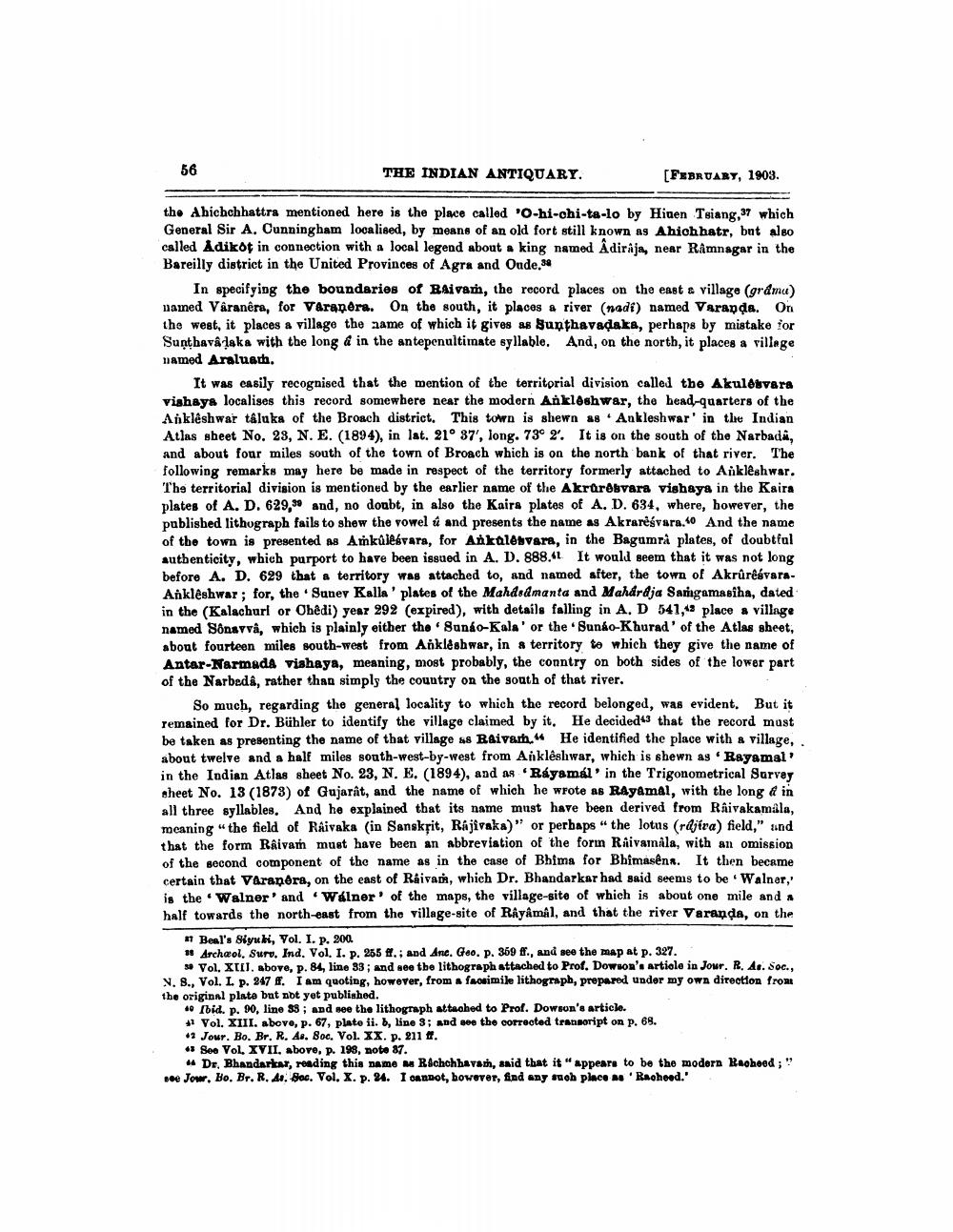________________
56
THE INDIAN ANTIQUARY.
[FEBRUARY, 1903.
the Ahichchhattra mentioned here is the place called 'O-hi-chi-ta-lo by Hiuen Tsiang,37 which General Sir A. Cunningham localised, by means of an old fort still known as Ahich hatr, but also called Adikot in connection with a local legend about a king named Adiraja, near Ramnagar in the Bareilly district in the United Provinces of Agra and Oude.34
In specifying the boundaries of RAivam, the record places on the east & village (gråmu) named Väranera, for Varandra. On the south, it places a river (nadi) named Varanda. On the west, it places a village the name of which it gives as Sunthavaqaka, perhaps by mistake for Sunthavalaka with the long & in the antepenultimate syllable. And, on the north, it places a village named Araluach.
It was easily recognised that the mention of the territorial division called the Akule vara vishaya localises this record somewhere near the modern Ankleshwar, the head-quarters of the Ankleshwar tâluka of the Broach district. This town is shewn as · Ankleshwar' in the Indian Atlas sheet No. 23, N. E. (1894), in lat. 21° 37', long. 73° 2'. It is on the south of the Narbada, and about four miles south of the town of Broach which is on the north bank of that river. The following remarks may here be made in respect of the territory formerly attached to Ankleshwar. The territorial division is mentioned by the earlier name of the Akrür@bvara vishaya in the Kaira plates of A. D. 629,99 and, no doubt, in also the Kairs plates of A. D. 634, where, however, the published lithograph fails to shew the vowel û and presents the name as Akrarēśvara.s0 And the name of the town is presented as Amkülêávara, for Ankale vara, in the Bagumri plates, of doubtful authenticity, which purport to have been issued in A. D. 888. It would seem that it was not long before A. D. 629 that a territory was attached to, and named after, the town of AkrûrêsvaraAnkleshwar; for, the Suner Kalla' plates of the Mahdodmanta and Maharaja Sarigamasiha, dated in the (Kalachurl or Obedi) year 292 (expired), with details falling in A, D 541, place a village named Sônavvå, which is plainly either the Sunko-Kala' or the Sunko-Khurad' of the Atlas sheet, about fourteen miles south-west from Ankleshwar, in s territory to which they give the name of Antar-Narmada vishaya, meaning, most probably, the conntry on both sides of the lower part of the Narbeda, rather than simply the country on the south of that river.
So much, regarding the general locality to which the record belonged, was evident. But it remained for Dr. Bühler to identify the village claimed by it. He decided that the record must be taken as presenting the name of that village 48 Raivam. He identified the place with a village, . about twelve and a half miles south-west-by-west from Ankleshwar, which is shewn as Rayamal in the Indian Atlas sheet No. 23, N. E. (1894), and as 'Ráyamál' in the Trigonometrical Survey sheet No. 13 (1878) of Gujarat, and the name of which he wrote as Rayamal, with the long & in all three syllables. And he explained that its name must have been derived from Raivakamala, meaning "the field of Raivaka (in Sanskrit, Rajivaka)" or perhaps the lotus (rdjiva) field," and that the form Raivan must have been an abbreviation of the form Riivamäla, with an omission of the second component of the name as in the case of Bhima for Bhimasena. It then became certain that varandra, on the east of Raivan, which Dr. Bhandarkar had said seems to be Walner.' is the Walner' and 'Wálner' of the maps, the village-site of which is about one mile and half towards the north-east from the village-site of Røyâmal, and that the river Varanda, on the
Beal's Siyuki, Yol. I. p. 200. 11 Archaol. Suro. Ind. Vol. I. p. 285 #: and Ane. Geo. p. 369 ff., and see the map at p. 327.
3 Vol. XIII, above, p. 84, line 83; and see the lithograph attached to Prof. Dowson's article in Jour. R. A.. Soc., X. 8., Vol. I. p. 247 . I am quoting, however, from a facsimile lithograph, prepared under my own direction from the original plate but not yet published.
** Ibid. p. 20, line 88; and see the lithograph attached to Prof. Dowson's article. *1 Vol. XIII. above, p. 67, plato ii. b, line 3; and see the corrected traumoript on p. 68. *Jour. Bo. Br. R. As. Soc. Vol. XX. p. 211 ti. ** See Yol XVII, above, p. 198, note 87.
Dr. Bhandarkar, reading this name as Rachchbayan, said that it " appears to be the modern Bacheed;" see Jow. Bo. Br. R. As. Soc. Vol. X. p. 24. I cannot, bowever, find any such place as 'Racheed.'




